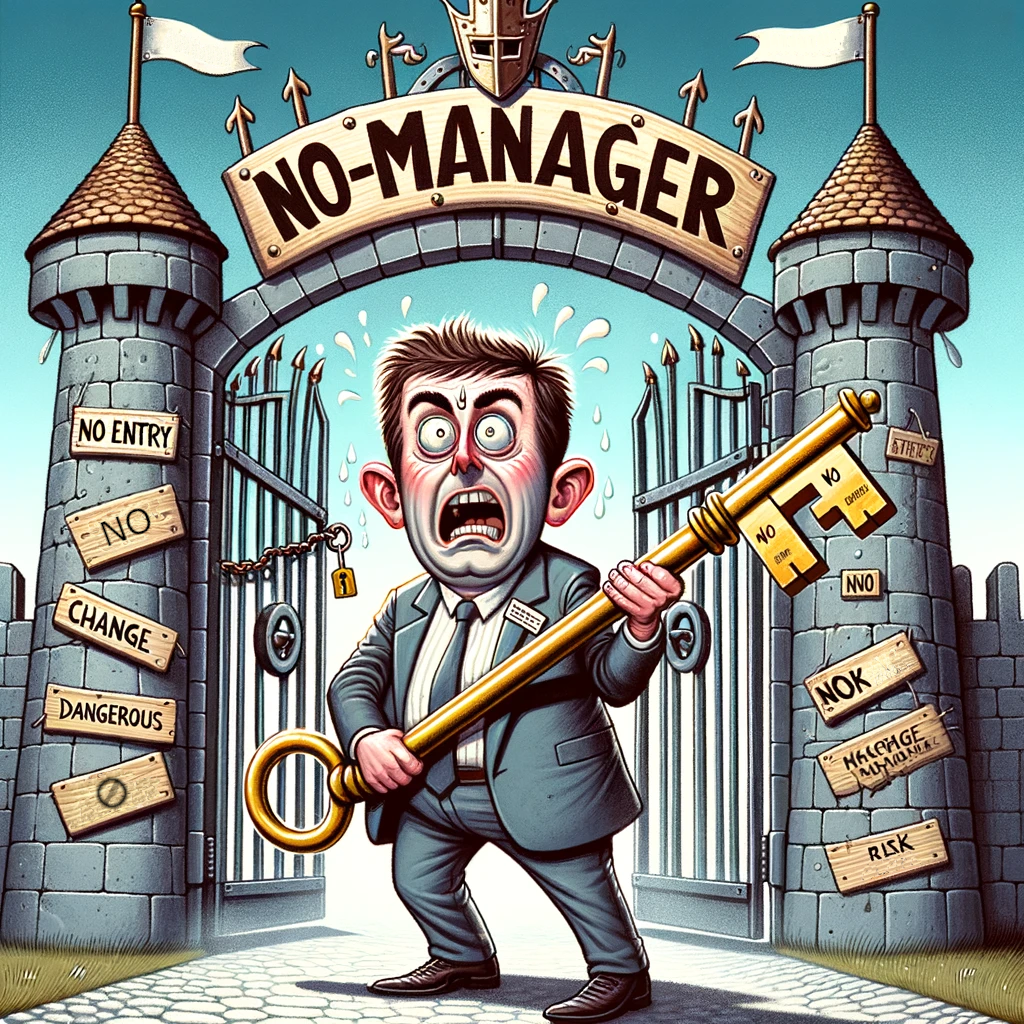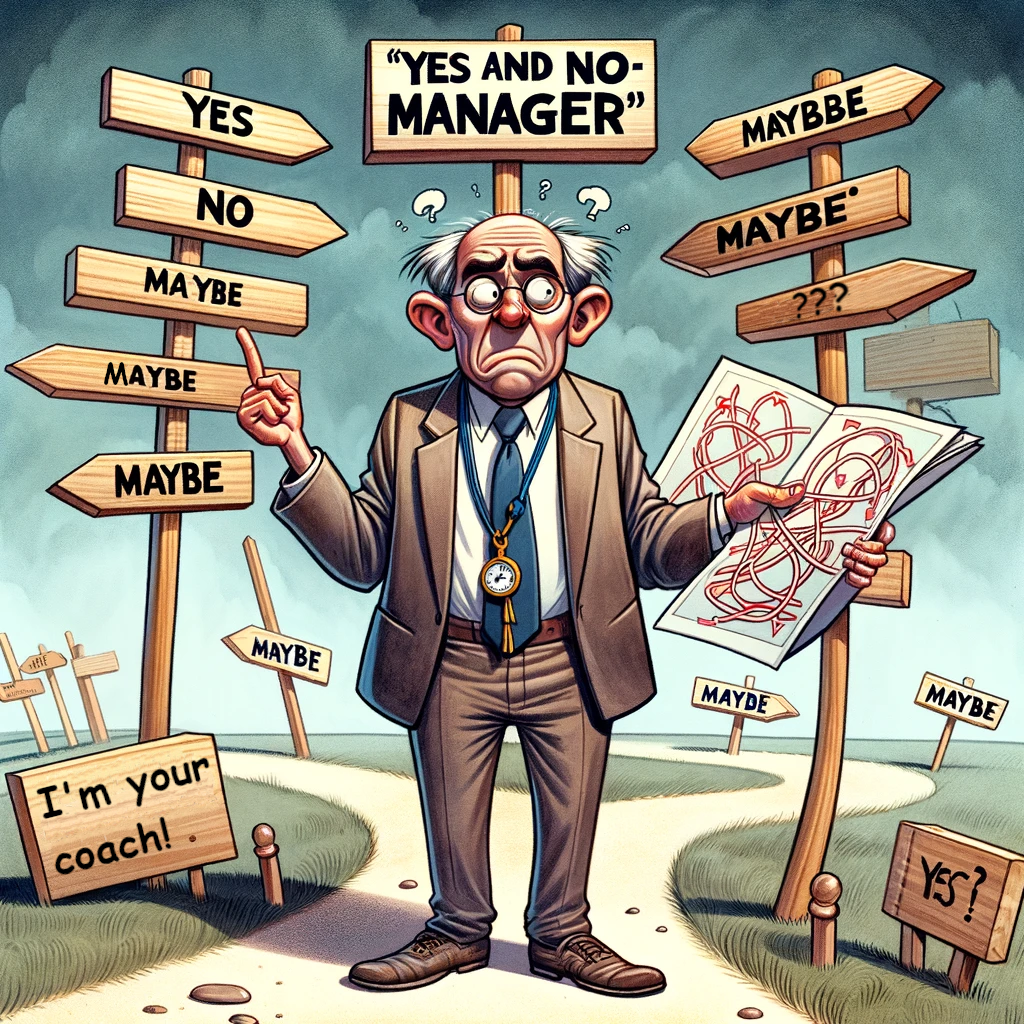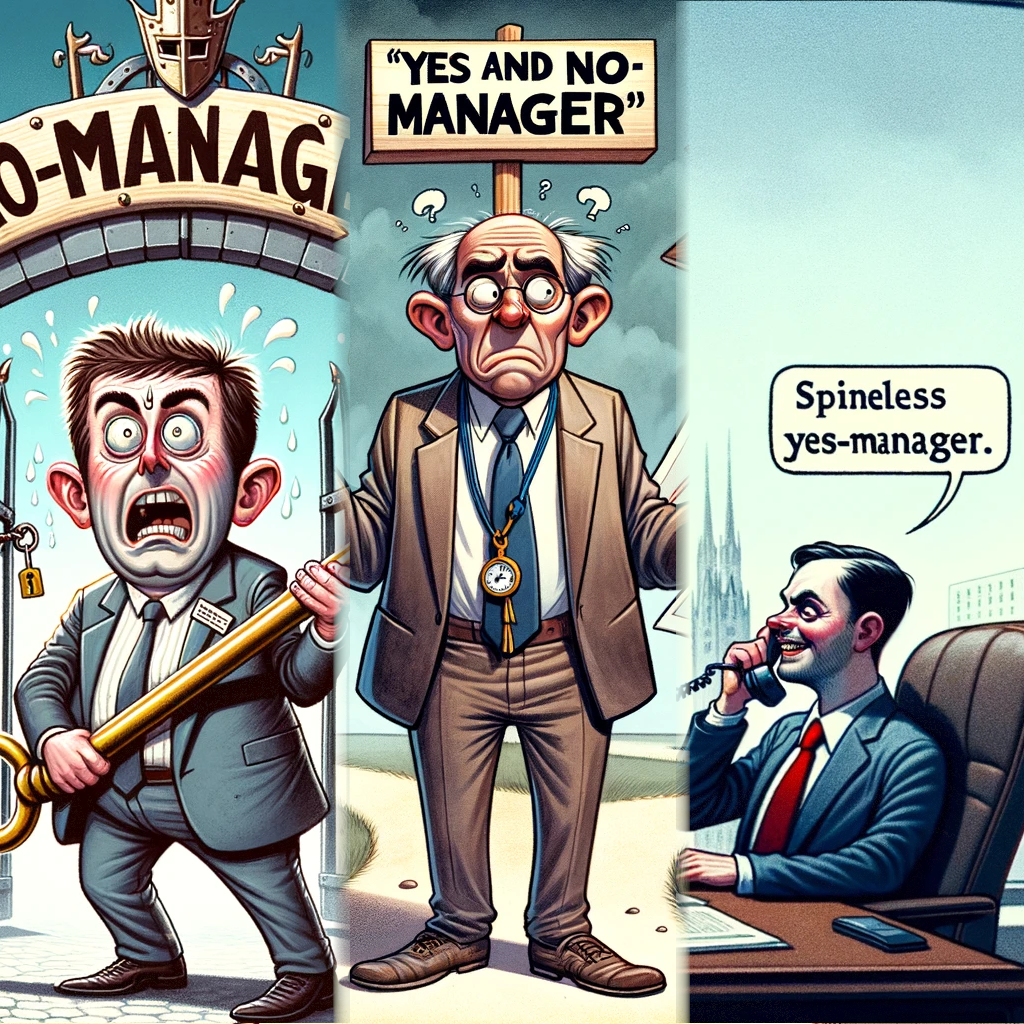During my career I’ve had a privilege of working with truly talented managers - managers who lead, inspire, and help the people around them grow.
At the same time, I’ve been a witness to dysfunction caused by managers with far less helpful behaviors. I call them “Yes-managers”, “No-managers”, and “Yes and No”-managers.
In this article I share these three dysfunction archetypes as I see them. There is no cookie-cutter advice I can give on how to deal with them, but forewarned is forearmed nonetheless.
But there’s also another danger - it’s easy not to notice if you are turning into one of them. Being a y-manager, n-manager, or a yn-manager is way easier than doing the actual work, so let’s not end up in one of these comfort zones.
The “Yes-Managers” aka Rubber Stamps
The “Yes-managers” are fascinating creatures, evolved to possess a backbone made of overcooked spaghetti.

Their primary activity is translating the executive demands to their teams with a minimal or no adaptation. Yes-managers never question or challenge the authority, and completely ignore the reality of the operational capability.
You can find them everywhere, as the superiors like them, their plans look perfect on paper, and when things finally go wrong, they can always come up with a good excuse.
What I found interesting is that if you ever voice your concern to a Yes-manager, to your utmost suprise, they will completely agree with you. They will nod their head, make reassuring remarks, but of course will do absolutely nothing to influence the decision from higher echelons, or at least voice your concerns to their superiors. Instead, the orders will stand exactly as they are, not even one iota changed.
Yes-managers are endorsing directives no matter how ludicrous or detached from practicality. Their affirmation of upper management’s whims leads to a team culture where critical thinking and innovation die, sacrificed at the altar of hierarchical harmony.
Why do they do what they do?
Here’s a bit of a “differential diagnosis” to recognize a yes-manager:
What they do |
Why they do it |
|---|---|
| Put a very high stress on their teams | “Pushing” the team over the limits is not a sign of a strong manager, it’s a sign of a weak one. This happens, because in the past the yes-manager has already promised a lot to their superiors. And now they don’t have any other choice rather than push the team to deliver on their overcommitment. |
| Avoid conflict | Yes-managers avoid getting into conflict, trying to hide the difference of perception or opinion, rather than to face and understand it to find a constructive resolution. “Let’s not rock the boat” |
| Use vague justifications | Explaining the rationale behind supporting an unrealistic initiative from the higher-ups to people familiar with the facts can get difficult, so the justifications in turn get vague and overly simplistic. |
| Non-committal commitment | Even the most optimistic y-manager realizes that if they commit to everything, they will not be able to execute. So it’s important to leave room for backpedaling, using the phrases like “I don’t see why not”. |
The “No-Managers” aka Gatekeepers
In direct contrast, the “No-managers” operate under a philosophy of pre-emptive rejection. Every new idea or request is a Trojan horse to them, laden with hidden risks. Their default response to any proposal is a resounding “No”.

This breed of manager has turned risk aversion into an art, erecting barricades around their departments. Under their watch, the department is isolated and “protected” from the outside influence. All suggestions and opportunities are viewed with suspicion and the status quo is worshipped.
You can find them mostly in large organizations, leading operations teams. They are popular in the teams they manage, as the teams know the manager is always “on their side”. The no-manager will protect the team from extra load or challenging tasks, creating a great comfort zone for the team and of course for themselves.
It’s important to remember that comfort that comes at a cost of rigidity will always result in a failure.
Eventually, the environment changes so much that the team cannot catch up, performance drops, and sanctions and layoffs start - usually to everyone’s surprise. How is it possible, we’ve always performed so well?
Why do they do what they do?
What no-managers often do:
| What they do | Why they do it |
|---|---|
| Express cynicism or pessimism | A general attitude of cynicism is a way for a no-manager to show they “know it all”. They know that change only leads to a catastrophe, and team initiatives are nothing more than an attempt of some individuals in the team to satisfy their ego. |
| Overemphasize on policy and procedure | No-managers like to hide behind company policy as a reason to avoid trying new things or making risky decisions. |
| Are reluctant to delegate | No-managers rarely trust anyone enough to delegate work. The fear that the team member makes a mistake that the no-manager will have to answer for is too high. |
| Overbloat costs | No-managers would present unrealistically high cost projections to implement an initiative, to dissuade the management from going ahead with the change. In this case, they don’t have to say “no”, instead they say “look, I’m all pro, it’s just the price is too high”. |
The “Yes and No Managers”: Masters of Ambiguity
Finally, we come to the “Yes and No managers”.
They are the reason why I decided to write the article in the first place. They are also the most difficult to recognize. Unfortunately, bullshitters somehow possess this great skill at imitating wisdom.
“Yes and No” managers dwell in a quantum state of decision-making, where every answer is simultaneously affirmative and negative until observed by a sufficiently frustrated colleague. When asked a concrete question, they embark on a lengthy discourse, filled with pros and cons, ultimately arriving at the destination of nowhere.

When the top management is too smart to trust yes-managers, the y/n-managers is their next pitfall. They sound wise and experienced with their impeccable pro and con analysis for every situation. They are also “help their people grow” by “not giving them all the answers”. Therefore, “yes and no”-managers are often found at the upper levels in the organization.
You: “Are we going to shut down the Alpha product line this year?”
Y/N-M: “Well, it’s yes and no. <Proceeds to explain how shutting it down is good, but not shutting it down is safer and maybe there are some customers still using it, yada yada>”
You: “So what should I do now?”
Y/N-M: “I want to return the question to you. So what should you do now?”
The difference between being a wise coach and being a y/n-manager is that y/n-managers would not actually help people find answers or make decisions. Instead they would spin with the winds of conversation, never committing to a single direction.
The difference between a good manager and a y/n-manager is that good managers know when to coach, when to teach, and when to take a decision themselves.
Ultimately, the difference is sincerety. Lead or pretend to lead. Help or pretend to help.
Why do they do what they do?
Here are some thoughts on Y/N-manager behaviors.
| What they do | Why they do it |
|---|---|
| Always non-commital responses | Their answer leave too much room for interpretation, without ever committing to a clear direction. This is what good coaches do, right? Right? |
| Analysis paralysis | To resolve the ambiguity, the y/n-managers instruct you to collect more data to take the right decision. Which is generally a good advice, but soon you will find yourself bringing more and more data only to find out that the data is still incomplete and more consideration is required. The exercise will continue until the decision is obvious (and then a simple Python script could have made it too), or until it becomes irrelevant. |
Because of their unparalleled skill at mimicry, I rate the y/n-managers the most dangerous type of the three.
Conclusion
Of course, a good manager is capable of saying and “Yes”, and “No”, and “Maybe”. Also good manager does not give easy answers to all the questions and gives room for growth. A good manager does not have answers to all the questions - because they hired people smarter than them to help find these answers.
Important is that a manager is not a machine to please their superiors, shield their team, and certainly not a fog-machine. A good manager is a human being - a person who is doing their best to create value, and helps the team to do the same - and of course makes mistakes and does their best to fix them.
Being a Yes-manager, No-manager, and “Yes and No”-manager is easy. Great leadership is hard. It requires balance, critical thinking, and courage to challenge the status quo.
That’s it, end of the post :)
